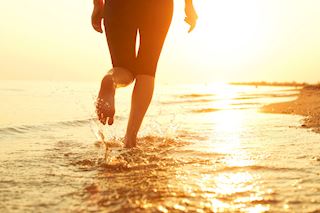Be One With Nature By Running As Nature Intended, Just Make Sure To Take It Slow And Smart
When you think about the way that our ancient ancestors ran, it wasn’t with a good pair of running shoes on their feet. Likely, instead of wearing their homemade leather moccasins that only slowed them down, they kicked them off and got to running. Barefoot running is the new craze sweeping the running world. A way for feet to reconnect with pavement, before you throw your shoes to the curb and hit the ground running, you are going to want to take preventative measures to ensure that you have the right training.
Sure, we were all made to run barefoot, but time, modernization, and civilization has beat it out of us. Barefoot running isn’t that natural anymore; it takes a lot of muscles that we don’t use very much.
A running shoe is created to provide stability to the foot while running. Not only for protection, many are cushioned in certain ways and lend support for those muscles in the feet, ankles, calves and legs which exhaust quickly. Have you ever heard of the limiting factor? It is a theory in chemistry that means when one factor is all used up the process can not longer continue. That is what running shoes are targeted to do, increase the strength of your limiting factor.
Many new running shoes on the market are being created for a more “free" form of run. The problem is that most of us don’t live in Kenya, we live in places where shoes are not optional. That has changed our mechanics and limited the strength that you have to run barefoot. It is an exhilarating experience as anyone who runs on a sandy beach knows, but it is also something that takes a lot more than just will. Training is essential for barefoot running.
If you want to engage in barefoot running and not end up injured, there are some basics that you should do to keep yourself strong and stable.
Challenge your balance
When training for barefoot running it is important to weight train the muscles of your feet, calves, ankles, and knees. More torque is going to be required of them to hold your feet stable while striking the pavement. You have to retain your brain for barefoot. Continually standing on unsteady surfaces of different types will help to strengthen the muscles you will need. Use things like foam rollers, cushioned discs or even make up your own obstacles. The key is to challenge your balance to help build the muscles back up in the feet to stabilize the leg the way it was made to do. Shoes have taken away the necessity for feet to do what they were designed for; you have to retrain them again.
Build slowly
Don’t think that you are going to go out and run a marathon, literally. Building up strength in your core musculature and the stability of your legs is going to take some time. Even if a five-mile run is like breathing to you, it is going to be very challenging at first. Make sure to go slow and build. Conditioned runners get what is called a “runner’s high”. The endorphins released will allow you to go farther without feeling any tension that you should. Anyone who has tried running barefoot knows that what felt okay the day of running is going not to feel so great in 24 hours time. Your feet have muscles just like everywhere else on the body when you tear them up; they are going to have to repair. If you try to go too quick, you can end up on the injured list.
Decrease shoe stability
It may be wise if you have time to decrease the amount of stability you have in your running shoe. Going from what you typically use to new products that are going to increase the strength of your bottom half with less support, is a good idea. Before you decide to bear it all, you may want to go through three stages of support with your shoes. It is an excellent way to build without injury.
Try different surfaces
Sand running and trail running barefoot are two very different experiences. To build your muscles to run barefoot you are going to want to try various types of surfaces to give your muscles a good challenge. You can even try running on the treadmill without shoes. The more surfaces you can try out, the better you are going to put your feet into conditions that will increase their capacity.
Barefoot running can be one of the most spiritual experiences a runner can have. If you take the time to build and don’t rush it, barefoot running will not only reconnect you with nature, it will make your legs and feet more stable and strong than you could have ever imagined.












